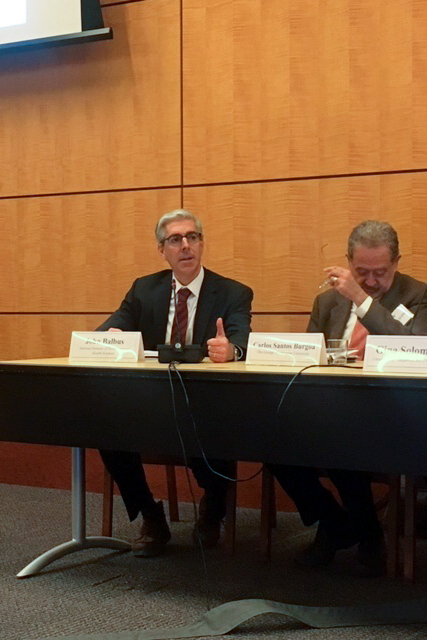Chemical exposures may prime the immune system for more extreme responses to infection, and infectious diseases influence the body’s response to exposures. The need to study this interplay is urgent, according to experts who joined a National Academy of Science, Engineering, and Medicine (NASEM) workshop Jan. 15-16 in Washington, D.C. The meeting was sponsored by the NASEM Emerging Science for Environmental Health Decisions.
During her opening remarks, NIEHS and National Toxicology Program Director Linda Birnbaum, Ph.D., pointed out that the 2018-2023 NIEHS Strategic Plan emphasizes interaction between the institute’s research and its other programs. An interdisciplinary approach is crucial for gaining insights into how environmental health and infectious disease management can interact.
 Environmental contaminants can alter the body’s response to disease-causing organisms, and vice versa.
Environmental contaminants can alter the body’s response to disease-causing organisms, and vice versa.“Exposure to environmental contaminants can alter the immune response to pathogens, and, of course, the pathogens can alter the response to the toxicants as well,” she told the audience. “So we have a two-way street we have to look at.”
For example, in a 1996 paper, Birnbaum reported that exposures to 2,3,7,8-tetrachlorodibenzo-p-dioxin altered the immune response of mice to the influenza virus and resulted in increased mortality. “This response has now been shown for things like air pollution, [which] can impact the response not just to influenza, but to staph and strep infections,” she said.
 Birnbaum observed that the themes of the NIEHS strategic plan overlapped with the themes of the workshop, namely, basic science, translation, training, involving people, and increasing scientific literacy. (Photo courtesy of NASEM)
Birnbaum observed that the themes of the NIEHS strategic plan overlapped with the themes of the workshop, namely, basic science, translation, training, involving people, and increasing scientific literacy. (Photo courtesy of NASEM)Entryways and the microbiome
According to several other speakers, the body’s microbiomes — especially the one in the gut — are likely suspects in the search for agents of this change because of their important roles in immune responses. Rodney Dietert, Ph.D., from Cornell University, pointed out that toxicological routes of exposure involve the same entryways, such as the skin, airway, and the gastrointestinal tract, that allow access to infectious agents.
“They are also the physical locations where the majority of the human microbiome is housed,” he noted. He listed the range of responses microbes might have to chemicals, drugs, foods, and other substances that come their way.
- Sequester — if it is something they want.
- Avoid — to keep it out.
- Metabolize — generating products that affect the host.
- Signal — among microbes and to the host.
- Die — “If it is a keystone bacteria with a unique function that you have to have, that is bad,” he noted.
“At some point environmental health became toxics health,” observed Carlos Santos-Burgoa, M.D., Ph.D., from George Washington University. “Somewhere, we lost track of [the fact that] the microbial world and chemical world are the same world.”
An example — mercury
Several speakers addressed the complex challenges of studying contaminants, infections, and the microbiome. Jennifer Nyland, Ph.D., from Salisbury University, discussed mercury’s role in provoking an inflammatory response in parts of the body, such as the brain and gut.
People are exposed to different forms of mercury, both organic and inorganic, she pointed out. “[These forms] affect the immune system,” she said. “They do not affect the immune system all in the same way. They do not have the same level of toxicity. And they are not metabolized in your system the same way.”
Her viral studies in mice found increased inflammatory responses and decreased anti-inflammatory action. But the responses were not seen with mercury alone. They were triggered only in the presence of a virus.
Calling on diverse disciplines
 Balbus chaired a closing panel focused on how the information shared at the workshop might play into research and policy decisions, from local to global levels. (Photo courtesy of NASEM)
Balbus chaired a closing panel focused on how the information shared at the workshop might play into research and policy decisions, from local to global levels. (Photo courtesy of NASEM)One theme of the workshop was that interdisciplinary, multidisciplinary, and transdisciplinary research approaches (see sidebar) are needed to uncover the interplay between pathogens and toxicants. This task calls on such disciplines as global health, epidemiology, and immunotoxicology, as well as sectors as diverse as agriculture, housing, health care, and transportation, to do this research.
John Balbus, M.D., NIEHS senior medical advisor and member of the workshop’s organizing committee, underscored the importance of an integrated approach. He highlighted the NASEM Environmental Health Matters Initiative as a potential avenue for continuing the discussion about new ways of doing things. NIEHS is one of the sponsors of that initiative.
Participants in the NASEM workshop included organizing committee member Josh Rosenthal, Ph.D., from the Fogarty International Center, and several NIEHS grantees.
Citation: Burleson GR, Lebrec H, Yang YG, Ibanes JD, Pennington KN, Birnbaum LS. 1996. Effect of 2,3,7,8-tetrachlorodibenzo-p-dioxin (TCDD) on influenza virus host resistance in mice. Fundam Appl Toxicol 29(1):40−47.









